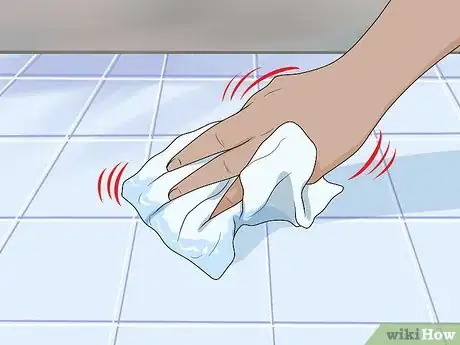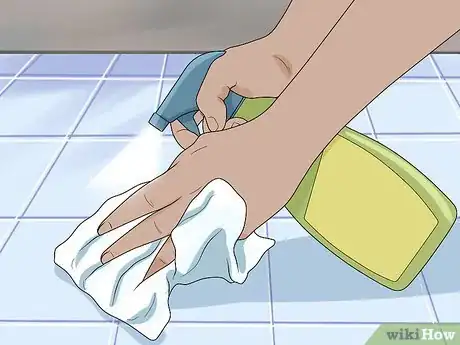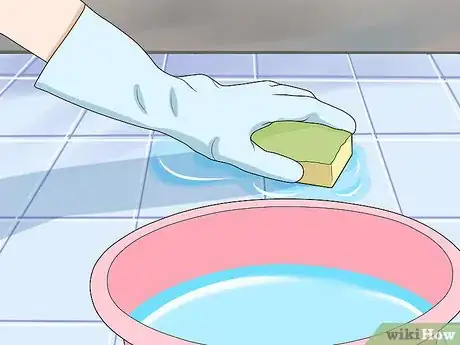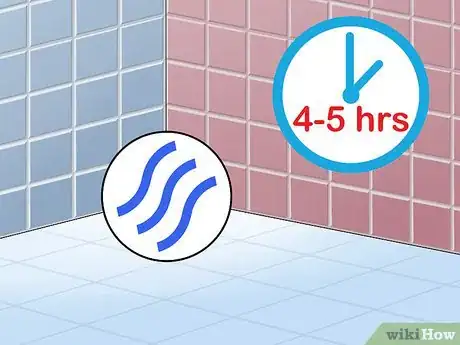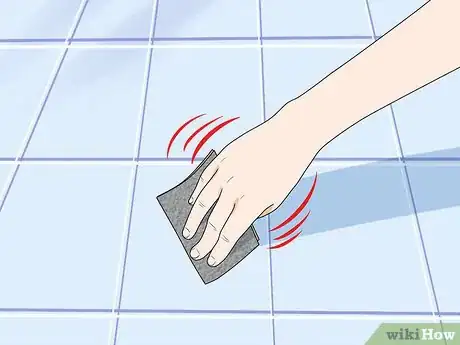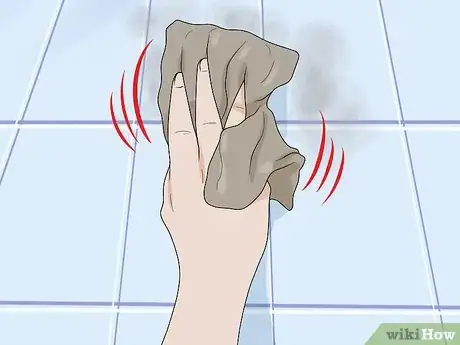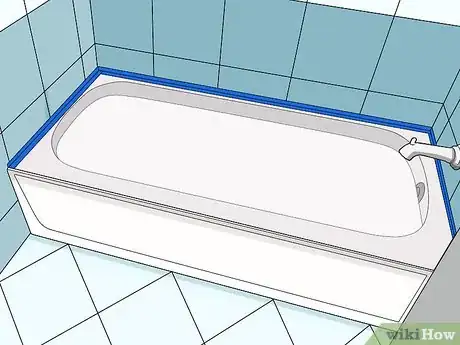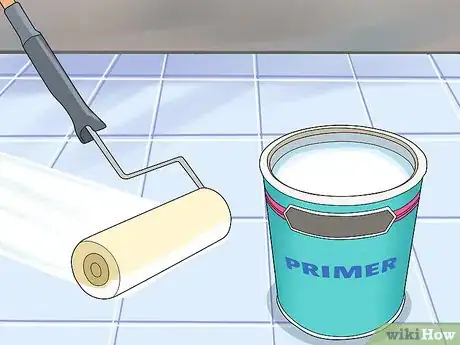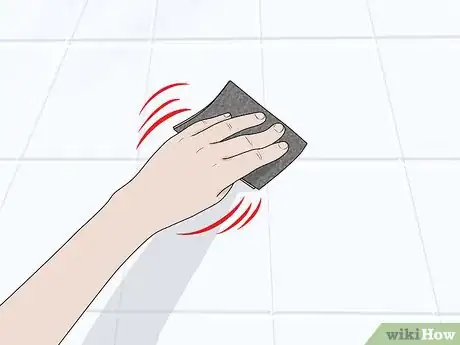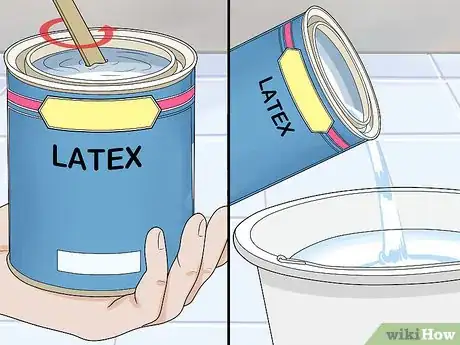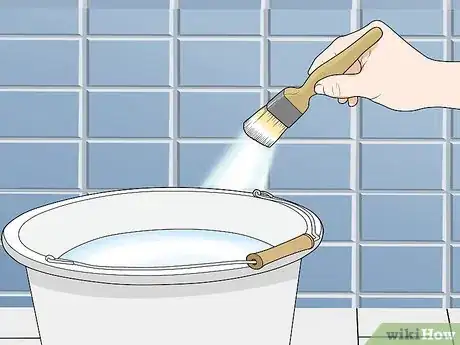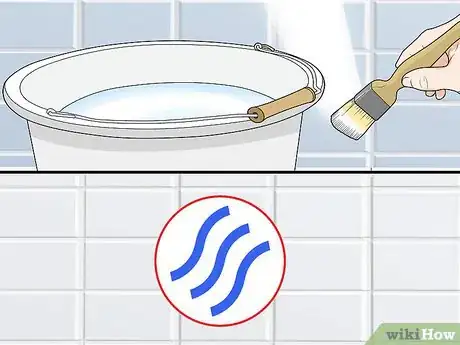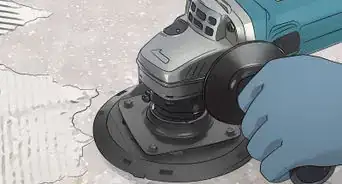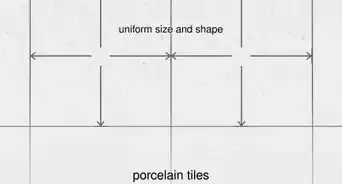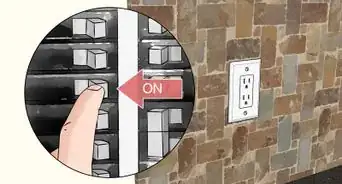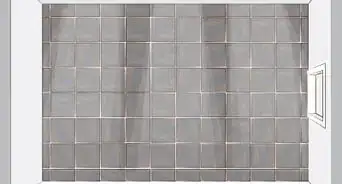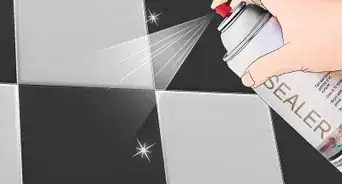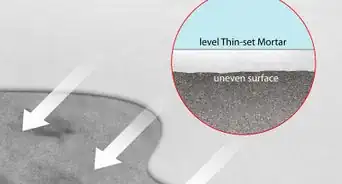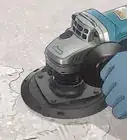This article was co-authored by Mitchell Newman. Mitchell Newman is the Principal at Habitar Design and its sister company Stratagem Construction in Chicago, Illinois. He has 20 years of experience in construction, interior design and real estate development.
This article has been viewed 32,953 times.
There's no need to tear up your entire bathroom if you want to redecorate or if you want a change of scenery. With the right type of paint, you can easily change the look of your bathroom. Before you paint the tiles, you'll need to clean them, sand them, and prime them. Once you've applied the paint, you'll be surprised at how different and vibrant your bathroom looks.
Steps
Cleaning and Preparing the Tile
-
1Wipe the tile with a wet cloth. Turn on your faucet and soak a cloth with water. Rigorously wipe the tile with the cloth. Make sure you remove any dirt or other stains on the surface of the tile. Run the wet cloth along the edges of the tile to give the whole tile an even clean.[1]
- You might find it very difficult to remove some dirt and stains from the tile. Only remove what you can with ease with the wet cloth.
-
2Soak a cloth in an abrasive bathroom cleaner and wipe the tile again. Abrasive bathroom cleaners remove the stains and dirt that have become embedded into the surface of the tile.[2]
- The abrasive bathroom cleaner will remove any mildew, dirt, or soap scum from the tile.
Advertisement -
3Use a wet sponge to remove the abrasive bathroom cleaner. Soak a sponge in water once you've finished removing dirt and other stains from the tiles. Gently wipe the bathroom cleaner from the tile. Make sure you remove any other residue left on the tile.[3]
-
4Give the tiles 4 to 5 hours to dry or wipe them dry with a cloth. It's important that the tile is completely dry before you move on to the next step. You can use paper towels to dry the tiles by hand if you don't have a cloth.[4]
- To check if the tile is dry, rub your finger across the surface.
-
5Sand the tile's surface with 180-grit sandpaper. Sanding the tile will remove any gloss from the surface. Use light pressure with the sandpaper so you don't scratch or damage the tile's surface.[5]
- If you want, you can use a synthetic sandpaper, such as aluminum oxide. Synthetic sandpaper is less likely to damage or scratch the surface of your tiles.
- You can also use an orbital sander. Be careful if you do use an orbital sander as it's much easier to damage the tile with a machine like that.
-
6Clean the surface with a damp cloth. After sanding, remove any leftover sand dust by wiping the surface of the tile with a damp cloth. Gently rub the surface with the cloth to remove the sand dust.[6]
- Give the tile an hour or two to dry after wiping it with the damp cloth.
- You can wipe the tiles dry with a dry cloth or paper towels so you don't have to wait before moving on.
Painting the Tile
-
1Protect the surrounding area. Before you start painting your tile, cover the other areas and surfaces of your bathroom. Cover the surface of the bath or shower with a large plastic sheet. Use painter's tape to keep the sheet in place.[7]
- Cover the adjacent tiles with painter's tape if you're painting a specific design.
-
2Prime the tiles you want to paint. Read the instructions on the tin of the primer before applying it. Use a roller to apply the primer evenly to the surface of the tiles. You can use a paintbrush if you don't have a roller.[8]
- Give the primer 4 hours to dry after applying it to your tiles.
-
3Use sandpaper on the primed tiles. You don't want to be too hard when sanding the primed tiles as you might remove the primer you just applied. Rub the tiles with 180-grit sandpaper to remove any imperfections from the surface.[9]
- The reason you need to sand again after priming the tiles is to ensure that you've removed all of the imperfections.
- You can also use an orbital sander. Make sure you have it on its lowest setting so you don't damage the tiles.
- Wipe the tiles with a damp cloth after sanding to remove any leftover sand dust.
-
4Buy latex paint and get it ready before painting. You can find latex paint at your local home decoration store. Latex paint is the best paint to use on tiles as it will properly bind to the surface. Stir the paint thoroughly while it's in the can, then pour it into a clean bucket or pot.[10]
-
5Paint the first coat with your paintbrush. Use even, measured strokes on your tiles. Again, you can use a roller to paint your tiles if you want. Make sure that you paint your tiles evenly and do your best to not paint the same area twice on the first coat.[11]
- After you've applied the first coat, let the paint dry overnight. You could paint the second coat a few hours after painting the first coat but it's best to be safe.
-
6Paint the first coat with your paintbrush and let it dry overnight. If you don't have time to wait overnight, leave the paint for 5 to 6 hours. Use a paper towel and gently dab the surface to see if the paint is dry. If not, give it 2 more hours. When the first coat is dry, you can paint the second coat. Using your roller or paintbrush, evenly paint the tiles with your latex paint.[12]
- When finished, allow the second coat to dry overnight.
- Use a damp cloth to wipe the tiles once the second coat has fully dried.
- If you think your tiles need another coat after the second, let the tiles dry after you've wiped them. Apply the third coat the same way you applied the first 2.
Expert Q&A
-
QuestionWhat kind of paint do you use on bathroom ceramic tile?
 Mitchell NewmanMitchell Newman is the Principal at Habitar Design and its sister company Stratagem Construction in Chicago, Illinois. He has 20 years of experience in construction, interior design and real estate development.
Mitchell NewmanMitchell Newman is the Principal at Habitar Design and its sister company Stratagem Construction in Chicago, Illinois. He has 20 years of experience in construction, interior design and real estate development.
Construction Professional You can typically find primer and paint that are specifically made for tile at a paint store.
You can typically find primer and paint that are specifically made for tile at a paint store.
Warnings
- Remember to wear safety goggles when sanding as you don't want sand dust flying into your eyes.⧼thumbs_response⧽
- Always wear a face mask when working with paints and primers as the fumes can be dangerous if inhaled directly.⧼thumbs_response⧽
Things You'll Need
- 5 clean cloths
- Abrasive bathroom cleaner
- A sponge
- 180-grit sandpaper
- Plastic sheeting
- Painter's tape
- Primer
- A paint roller
- A soft-bristled paintbrush
- Latex paint
- A bucket or pot
References
- ↑ https://www.drivenbydecor.com/how-painting-bathrooms-ceramic-tile-floors-diy/
- ↑ http://www.naturallivingideas.com/clean-tiles-grout/
- ↑ http://www.naturallivingideas.com/clean-tiles-grout/
- ↑ https://www.drivenbydecor.com/how-painting-bathrooms-ceramic-tile-floors-diy/
- ↑ https://www.realtor.com/advice/home-improvement/how-to-paint-ceramic-tile/
- ↑ https://www.realtor.com/advice/home-improvement/how-to-paint-ceramic-tile/
- ↑ http://www.homelife.com.au/craft-diy/diy/how-to-paint-tiles
- ↑ http://www.homelife.com.au/craft-diy/diy/how-to-paint-tiles
- ↑ https://www.drivenbydecor.com/how-painting-bathrooms-ceramic-tile-floors-diy/
About This Article
If you want to paint your bathroom tiles, start by scrubbing them with an abrasive bathroom cleaner then lightly sanding the surface with 180-grit sandpaper. From there, apply primer to tiles and give it 4 hours to dry before sanding again to remove any imperfections. Once you’ve sanded your tiles, use a paintbrush or roller to apply a coat of latex paint. Make sure to paint your tiles evenly and do your best not to paint the same area twice on the first coat. Let the paint dry overnight before applying a second coat. If you think your tiles need a third coat, give the paint another night to dry before painting again. For more help, like how to protect the area around your tiles from paint, scroll down.
